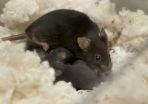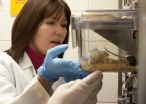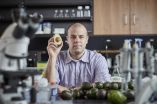INFORMATION:
Kelleher is also associate professor of pharmacology and surgery, College of Medicine, and nutritional sciences, College of Health and Human Development. Sooyeon Lee, graduate student, nutritional sciences and cellular and molecular physiology; Samina Alam, research associate, cellular and molecular physiology and surgery, both at Penn State; Stephen R. Hennigar, former graduate student, nutritional sciences, and currently a postdoctoral scientist, U.S. Army Research Institute of Environmental Medicine; and Keigo Nishida, research scientist, RIKEN Center for Integrative Medical Sciences, and assistant professor, pharmaceutical sciences, Suzuka University of Medical Science, all worked on this research as well.
The National Institutes of Health and the Penn State College of Medicine department of surgery supported this research.
Mutation in zinc transport protein may inhibit successful breastfeeding
2015-06-15
(Press-News.org) Zinc plays an important role in a woman's ability to successfully breast-feed her child, according to health researchers.
It has long been known that zinc, an essential trace element, is passed to infants through mother's breast milk. The levels of zinc in mother's milk and the effects of zinc deficiency in infants have been previously studied, but the role of zinc in breast development and function in lactating mothers is a relatively new area of research.
The protein ZnT2 transports zinc in specific tissues in the body, including the mammary glands. Shannon L. Kelleher and colleagues have previously found that some women have mutations in ZnT2, and that when the protein does not function correctly, breast milk will have very low amounts of zinc, which can cause severe zinc deficiency in exclusively breast-fed infants. Their recent research on mice suggests that ZnT2 mutations may also cause other deficiencies in breast milk and may create difficulty for breast-feeding in general.
"This finding changes the paradigm," said Kelleher, associate professor of cellular and molecular physiology, Penn State College of Medicine. "It is no longer only about transporting zinc into milk, but now it's also about milk composition and milk production."
The researchers studied the function of ZnT2 by observing the development of mammary glands in mice -- both with and without functioning ZnT2 -- reporting their results in the current issue of the Journal of Biological Chemistry. The group of mice lacking ZnT2 showed reduced mammary gland development and severe defects in function during lactation.
ZnT2 transports zinc by importing it into vesicles -- small organelles within the cell -- that then secrete zinc into the breast milk. Zinc is also necessary to trigger the growth of mammary glands, mammary epithelial cells and secretion pathways. Kelleher and colleagues found that without functional ZnT2, zinc accumulates in the cytoplasm, becoming toxic to the cell.
"It is believed that 'breast is best,' but breast-feeding is hard to do," said Kelleher, pointing out that breast-feeding isn't instinctive, but is a learned behavior. "We believe that there is biology behind some breast-feeding issues. If we can identify women who will have trouble with breast-feeding while they're still pregnant (by identifying mutations in their ZnT2 proteins), then maybe we can help them better prepare before the baby comes."
If zinc is not transported by ZnT2, its absence impacts milk composition and volume. The researchers found that along with insufficient zinc levels in breast milk, mice without ZnT2 had significantly reduced beta-casein, fat and lactose in their milk. All are important for sustaining infant health. These mice were also unable to produce an adequate volume of milk for their offspring.
"We really need to better understand the biological factors of lactation," said Kelleher. "Seventy-five percent of mothers intend to breast-feed when they leave the hospital. Six months later, only 14 percent are still exclusively breast-feeding."
In the future, Kelleher hopes to sequence the gene that codes for ZnT2 in women to figure out how lactation is affected and how to help pregnant and lactating women who have ZnT2 mutations.
ELSE PRESS RELEASES FROM THIS DATE:
Buckle up for fast ionic conduction
2015-06-15
This news release is available in German. ETH material engineers found that the performance of ion-conducting ceramic membranes that are so important in industry depends largely on their strain and buckling profiles. For the first time, scientists can now selectively manipulate the buckling profile, and thus the physical properties, allowing new technical applications of these membranes.
"Ionics, ion-based data processing and energy conversion, is the electronics of the future", says Jennifer Rupp, a professor of Electrochemical Materials at ETH Zurich, and therewith ...
New study favors cold, icy early Mars
2015-06-15
WASHINGTON, D.C. - The high seas of Mars may never have existed, according to a new study that looks at two opposite climate scenarios of early Mars and suggests that a cold and icy planet billions of years ago better explains water drainage and erosion features seen on the planet today.
For decades, researchers have debated the climate history of Mars and how the planet's early climate led to the many water-carved channels seen today. The idea that 3 to 4 billion years ago Mars was once warm, wet and Earth-like with a northern sea -- conditions that could have led ...
How an animal's biochemistry may support aggressive behavior
2015-06-15
Researchers who paired Siamese fighting fish in mock fights found that winning fish could supply more energy to their muscles during fights than losing fish.
The findings link the invisible processes going on inside cells to tangible consequences in the visible world, and they show how a behavior such as aggression can be affected by underlying biochemical processes that help sustain an animal's life.
"Conspicuous adaptations like antlers are usually what come to mind when thinking about traits that maximize success in aggressive interactions, but as these interactions ...
Avocados may hold the answer to beating leukemia
2015-06-15
Rich, creamy, nutritious and now cancer fighting. New research reveals that molecules derived from avocados could be effective in treating a form of cancer.
Professor Paul Spagnuolo from the University of Waterloo has discovered a lipid in avocados that combats acute myeloid leukemia (AML) by targeting the root of the disease - leukemia stem cells. Worldwide, there are few drug treatments available to patients that target leukemia stem cells.
AML is a devastating disease and proves fatal within five years for 90 per cent of seniors over age 65. Spagnuolo's new avocado-derived ...
Research reveals insights on how ancient reptiles adapted to life in water
2015-06-15
The world's first study into the brain anatomy of a marine reptile that lived at the same time as the dinosaurs sheds light on how the reptilian brain adapted to life in the oceans.
The fossils of ichthyosaurs, which lived 150 to 200 million years ago, are often very well preserved, but they are commonly flattened. Now investigators have used computed tomography to create a 3-D scan of the animal's skull, revealing internal details of the palate and braincase that usually cannot be seen. A reconstruction of the brain shows the importance of vision for the predator, which ...
Air pollution may contribute to white matter loss in the brain
2015-06-15
In a new study, older women who lived in places with higher air pollution had significantly reduced white matter in the brain. For the study, a research team took brain MRIs of 1403 women who were 71 to 89 years old and used residential histories and air monitoring data to estimate their exposure to air pollution in the previous 6 to 7 years.
The findings suggest that ambient particulate air pollutants may have a deleterious effect on brain aging.
"Investigating the impact of air pollution on the human brain is a new area of environmental neurosciences. Our study provides ...
Study examines trends in smoking among health students
2015-06-15
The prevalence of smoking among undergraduate nursing and physiotherapy students in Spain decreased from 29.3% in 2003 to 18.2% in 2013. Many of the students remained unaware of the link between smoking and diseases such as bladder cancer or the negative health effects of second-hand smoke, which points to a significant deficiency in undergraduate training.
The majority of nursing and physiotherapy students recognized that healthcare professionals were role models in society, noted Dr. Beatriz Ordás, lead author of the Journal of Advanced Nursing study.
INFORMATION: ...
Use of osteoporosis drugs have dropped following media reports of safety concerns
2015-06-15
Following a decade of steady growth, use of bisphosphonates--medications that are effective for treating osteoporosis--declined in the United States by more than 50% from 2008 to 2012.
The sudden drop seemed to occur after media reports highlighted safety concerns, such as the development of certain fractures that occurred rarely in long-term users, despite the fact that the US Food and Drug Administration and the American Society of Bone and Mineral Research did not recommend any specific safety restrictions on bisphosphonates. The findings are published in the Journal ...
Study provides insights on chronic lung disease
2015-06-15
A new study shows that shorter telomeres--which are the protective caps at the end of a cell's chromosomes--are linked with worse survival in a progressive respiratory disease called idiopathic pulmonary fibrosis (IPF). In patients with IPF, excessive scar tissue forms in the lungs.
The average telomere length of IPF patients was significantly shorter than that of healthy individuals. Also, the telomere length of patients with IPF who died from their disease during the study was shorter than that of patients who survived.
The Respirology results support the theory that ...
Elder abuse is common around the world
2015-06-15
A new global review reveals that elder abuse--which includes psychological, physical, and sexual abuse; neglect; and financial exploitation--is common among community-dwelling older adults and is especially prevalent among minority older adults. Older adults with cognitive and physical impairments or psychosocial distress are also at increased risk of elder abuse.
In North and South American epidemiological studies, the prevalence of elder abuse ranged from about 10% among cognitively intact older adults to 47% in older adults with dementia. In Europe, the prevalence ...




